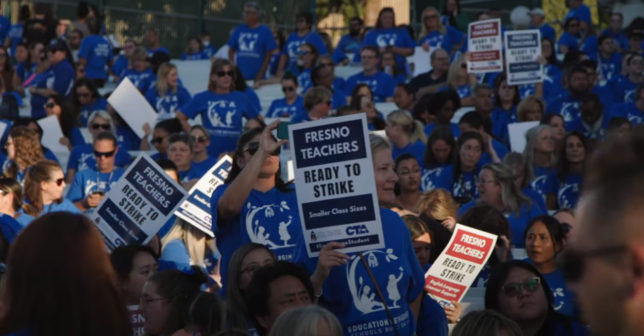Labor Watch
An Inside Look at the Threat of a Teachers’ Strike


Homeless encampments in the parking lots. Free laundry services for all employees. Piloting of a four-day work week. Free yoga and meditation classes for all families in the district. Paid mental health days for all teachers.
These are just some of the demands from the Fresno Teachers Association, whose members serve one of the largest school districts in the nation. In light of labor unions nationwide celebrating sweeping victories for their members, it is no surprise that many of our education unions are quick to follow in renegotiating their working conditions. Fast food workers in California are now guaranteed a $20-an-hour minimum wage. Once considered some of the lowest-paid workers, they will make more than most paraeducators and substitute teachers in the state. The United Auto Workers won record pay hikes with their recent walkouts, with some workers receiving a 33 percent increase in pay. Unions across the nation are flexing their power, and the teachers unions want a slice of the pie.
Preparing to Strike
I was able to interview a teacher who is currently a member of the Fresno Teachers Association and an elementary teacher for the Fresno Unified School District to get an inside scoop on the events leading up to the possible strike and what it will look like if the district doesn’t cower to the union’s demands. She wants to remain anonymous, so let’s call her Teacher X.
When I called Teacher X, she was at the hardware store buying bicycle chains and padlocks for her classroom. She just had a substitute teacher in her class due to a sick day and was met with chaos when she returned. The internet cable was ripped off the wall, one of the chairs was broken, a student was kicked, and several students dog piled a student with special needs. Luckily, no student was seriously injured, but you can imagine that she would hesitate to take another sick day.
Now, she has to prepare for the possibility of an ongoing strike in which rapidly hired and inexperienced subs will be crossing the picket line to staff the classroom while the union members protest. She is purchasing the padlocks for the cupboards and bicycle chains for the larger supplies. The strike was scheduled to start on November 1. I spoke with her two days earlier.
Subs who work for the district typically get paid around $200 a day, but during the strike, the district had committed to paying substitute teachers $500 a day. The district also preemptively spent one million dollars on packet work that the substitutes would have used as lesson plans during the possible strike. From the looks of it, they are preparing to stand their ground.
Teacher X shared that 3,600 teachers are getting ready to strike, so the district will be extremely short-staffed despite the efforts by the district to pay substitutes handsomely. The administrators at the school sites are preparing for classes to be combined and even bringing students into the cafeteria to be transformed into mega classrooms.
Not all teachers are planning to strike. The unions refer to replacement workers by the derogatory nickname “scabs” in reference to something that covers for a wound. Also, some of the nontenured regular teachers were concerned about retribution from the district if they joined the strike. Several teachers who are close to retirement also do not want to participate. As Teacher X put it, “They have one foot out the door,” so understandably, they don’t want to rock the boat. Union members participating in the strike were encouraged by the union to leave a letter for the scabs about how they were hurting their efforts.
If the strike still happens, union members will report to the picket line just like regular work, according to Teacher X. They will be allowed a two-hour rest period for their lunch. The union wants a strong show of force, especially when parents are picking up and dropping off their children.
Even though the news has picked up the more ridiculous demands by the union, such as homeless encampments in the parking lots, the main issues that the union members want are more reasonable, such as smaller class sizes, an increase in teacher’s salaries to keep up with inflation, and a significant reduction in workload for special education teachers.
Teacher X stated that the union aims for a 13 percent salary increase for teachers. The district offered 6 percent, with half of the cost coming from the teacher’s health benefits. This means that teachers would receive the pay increase if they were willing to pay more for their health benefits, which the union calls robbing Peter to pay Paul.
Mismanagement of Funds
Some of the mismanagement of funds within the district has been exposed during this process. Teacher X shared that the State of California gave all school districts billions to give bonuses to every employee. The district decided to give the upper management $10K while the teachers received $5K if they had a near-perfect attendance rate. The district also spent money on what Teacher X refers to as “fluff departments,” including a 63-person Department of Equity to handle racial sensitivity and LGBTQ initiatives. They also bought unnecessary 80-inch TV screens for most classrooms. On top of this, money was given to schools during the COVID lockdowns from the federal government. There is an excess of funds, but the teachers aren’t seeing an increase in their salaries.
Teacher X shared that she wants taxpayers to know what the district is doing with their money. She disagrees with the union’s extra, such as the millions to be used for students’ social welfare services, including allowing homeless families to park in the parking lots with paid private security. The sad reality is that most homeless individuals are drug addicts or mentally ill, so it’s a fair question to ask if the parents of these families who would be living in the school parking lots so near to the children of the public school have one or both of these problems. She mentioned that a lot of members in the union think that school should be a “catch-all for all the woes of society.” She believes that these unnecessary and ridiculous demands are hurting the negotiations.
The Agreement
In the end, as I was writing this blog post, the strike was called off at the midnight hour due to the district capitulating to some of the demands of the union. Looks like class sizes were not reduced, teachers received an 8 percent raise, and $33 million will be used to fund the social welfare programs, including the encampments for homeless student families. I spoke with Teacher X again, and she is jaded. She was hoping for a classroom-size reduction.
As a former 15-year public school teacher, I never was a union member due to political and religious beliefs, but I did appreciate the salary hikes they negotiated for us. But there always seems to be an extra agenda in these fights.
There are pros and cons to this system of unions fighting tooth and nail with their employers to meet their demands, some of which are ridiculous. But I can’t help but think of who gets hurt when this is how we negotiate the education of our nation’s children. If the Fresno teachers do strike, Teacher X warned, “I would not send my child to school during that time. I don’t have the confidence that the subs can keep these kids under control.” Those who suffer under this dysfunctional system are the students.



